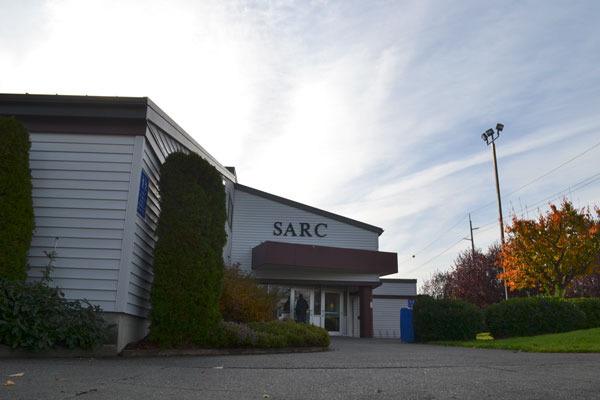The majority of Sequim residents polled in a telephone and online survey — both users and non-users of the Sequim Aquatic Recreation Center — had positive responses to a possible YMCA/SARC partnership.
That’s the summation from Kyle Cronk, CEO of the Olympic Peninsula YMCA, after reviewing results of a survey conducted in October by the Spokane-based Strategic Research Associates company.
“The question we wanted to answer was, ‘Do you want to see a YMCA come to this community?’,” Cronk said. “Overwhelmingly you have said, ‘Yes.’”
Cronk and Joanne Vega, director/partner with Strategic Research Associates, delivered highlights of the survey to a packed room at the Sequim Civic Center on Nov. 18.
Nearly 70 percent of all survey-takers had a positive response to a possible co-management of SARC, a multi-use athletic facility at 610 N. Fifth Ave., that closed on Oct. 30 after running out of operating funds.
“There is an urgency now,” Cronk said. “SARC is closed. This is a community-wide solution to open its doors.”
SARC still would be community owned, SARC board chairman Frank Pickering said, while the YMCA would present a “management contract” to the SARC board of commissioners for approval.
“This is just the next step,” Pickering said.
Partnership possibilities
Survey results indicate the Sequim community could support about 1,000 “membership units” of varying prices totaling between $73,000 and $82,000 in monthly revenues, Cronk said. That means the facility which sees a large portion of its operating costs come from its main and shallow pool would need more funding than what comes in the door, he said.
“Pools on their own are unsustainable,” Cronk said. “We would not be able to operate in the red.”
Cronk said a YMCA/SARC partnership still would need to seek help from other community entities to be part of the partnership; the Olympic Peninsula YMCAs operate with 10 to 15 percent of operating costs coming from “contributed support,” Cronk estimated.
Those partners could include the City of Sequim to Clallam County to Olympic Medical Center, Clallam County, local schools, the Shipley Center and others, he said.
“This is not just a YMCA-SARC commissioner conversation,” Cronk said. “This is a much bigger conversation. We need to get SARC back open again (but) I’d ask for a little bit of patience. There are a lot of moving parts.”
Sequim City Manager Charlie Bush said his organization is interested in being included in the conversation about the partnership, but with a caveat about funding: “This isn’t something the city can do on its own,” Bush said. He noted that the majority of SARC users live outside of the city limits and that any possible funding from city coffers should be drawn proportionally.
“It has to be fair from our perspective,” Bush said.
The meeting drew interest from dozens of community members plus representatives from the City of Sequim, Sequim School District, Olympic Medical Center and newly elected Clallam County Commissioner Mark Ozias, among others.
“We’re very interested in partnering with the YMCA,” Olympic Medical Center CEO Eric Lewis said last week. “It makes a lot of sense for us and the YMCA and the community.”
Possible changes
Cronk said the YMCA board of directors plans to talk about the survey results at its Nov. 25 regular meeting, but that there is no set timeline for a YMCA/SARC proposal.
“It could be a month, could be two months,” Cronk said.
Cronk said he’s already looking at possible solutions to help cut funding and grow revenue sources at SARC, from repurposing or downsizing to renting out portions of the facility.
The YMCA leader also said he is looking at how to ensure low-income families and individuals can use SARC in the future.
“Not everyone can pay for use of a facility like SARC,” Cronk said, but added the YMCA traditionally will find ways through philanthropic sources to make sure they can.
“We make that promise across the Olympic Peninsula; that’s not going to change,” Cronk said.
Inside the survey
Vega, the research specialist from the Strategic Research Associates, said survey results were culled from 245 SARC users, 404 from non-users and 784 online responses. The phone surveys were completed in October before the announcement of SARC’s closure and the firm saw some online responses come in after the announcement.
Vega said it’s the largest online turnout she’s seen.
“We try to get at least 400 (responses) in a population of Sequim’s size,” she said.
About 70 percent of SARC users and 68 percent of non-SARC users said they are favorable for a partnership with the YMCA.
Most (57 percent) prefer one or more adult memberships compared to 39 percent joining with family passes.
The survey polled residents about possible price rate increases, Vega said. Current SARC users were more sensitive to possible price increases, Vega said. She noted about 5 percent of SARC users said they were less likely to join with a rate bump — between $45-$55 for an individual adult monthly pass — while non-users showed more of an interest — from 56 percent to 64 percent — after being told of the price rates.
The survey also polled residents about their willingness to contribute to programs that help low-income users access the facility, with about 30 percent of SARC users and about 23 percent of non-users expressing willingness to donate for such programs.
Despite a strong overall positive response, Vega said her research firm tempered the numbers of residents — 56 percent of SARC users and 30 percent of non-SARC users — who said they are “likely to join” a proposed YMCA-SARC-led facility within the next 12 months.
Vega estimated about 12.4 percent of the Sequim market actually would purchase some kind of membership, she said.
“A healthy amount of conservatism is good at this point,” Cronk said.
Vega and Cronk said the survey results will be posted online for public access, but not before the Thanksgiving holiday.



